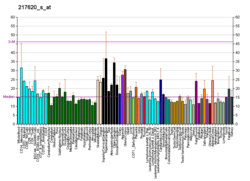PIK3CB
Phosphatidylinositol-4,5-bisphosphate 3-kinase catalytic subunit beta isoform is an enzyme that in humans is encoded by the PIK3CB gene.[5][6]
Phosphoinositide 3-kinases (PI3Ks) phosphorylate the 3-prime OH position of the inositol ring of inositol lipids. They have been implicated as participants in signaling pathways regulating cell growth by virtue of their activation in response to various mitogenic stimuli. PI3Ks are composed of a 110-kD catalytic subunit, such as PIK3CB, and an 85-kD adaptor subunit (Hu et al., 1993).[supplied by OMIM][6]
References
- 1 2 3 GRCh38: Ensembl release 89: ENSG00000051382 - Ensembl, May 2017
- 1 2 3 GRCm38: Ensembl release 89: ENSMUSG00000032462 - Ensembl, May 2017
- ↑ "Human PubMed Reference:".
- ↑ "Mouse PubMed Reference:".
- ↑ Hu P, Mondino A, Skolnik EY, Schlessinger J (Jan 1994). "Cloning of a novel, ubiquitously expressed human phosphatidylinositol 3-kinase and identification of its binding site on p85". Mol Cell Biol. 13 (12): 7677–88. PMC 364839. PMID 8246984.
- 1 2 "Entrez Gene: PIK3CB phosphoinositide-3-kinase, catalytic, beta polypeptide".
Further reading
- Katada T, Kurosu H, Okada T, et al. (1999). "Synergistic activation of a family of phosphoinositide 3-kinase via G-protein coupled and tyrosine kinase-related receptors". Chem. Phys. Lipids. 98 (1–2): 79–86. doi:10.1016/S0009-3084(99)00020-1. PMID 10358930.
- Lee C, Liu QH, Tomkowicz B, et al. (2004). "Macrophage activation through CCR5- and CXCR4-mediated gp120-elicited signaling pathways". J. Leukoc. Biol. 74 (5): 676–82. doi:10.1189/jlb.0503206. PMID 12960231.
- Carpenter CL, Duckworth BC, Auger KR, et al. (1991). "Purification and characterization of phosphoinositide 3-kinase from rat liver". J. Biol. Chem. 265 (32): 19704–11. PMID 2174051.
- Bonnefoy-Bérard N, Liu YC, von Willebrand M, et al. (1995). "Inhibition of phosphatidylinositol 3-kinase activity by association with 14-3-3 proteins in T cells". Proc. Natl. Acad. Sci. U.S.A. 92 (22): 10142–6. doi:10.1073/pnas.92.22.10142. PMC 40752. PMID 7479742.
- Hu P, Schlessinger J (1994). "Direct association of p110 beta phosphatidylinositol 3-kinase with p85 is mediated by an N-terminal fragment of p110 beta". Mol. Cell. Biol. 14 (4): 2577–83. doi:10.1128/mcb.14.4.2577. PMC 358625. PMID 8139559.
- Milani D, Mazzoni M, Borgatti P, et al. (1996). "Extracellular human immunodeficiency virus type-1 Tat protein activates phosphatidylinositol 3-kinase in PC12 neuronal cells". J. Biol. Chem. 271 (38): 22961–4. doi:10.1074/jbc.271.38.22961. PMID 8798481.
- Mazerolles F, Barbat C, Fischer A (1997). "Down-regulation of LFA-1-mediated T cell adhesion induced by the HIV envelope glycoprotein gp160 requires phosphatidylinositol-3-kinase activity". Eur. J. Immunol. 27 (9): 2457–65. doi:10.1002/eji.1830270946. PMID 9341793.
- Borgatti P, Zauli G, Colamussi ML, et al. (1998). "Extracellular HIV-1 Tat protein activates phosphatidylinositol 3- and Akt/PKB kinases in CD4+ T lymphoblastoid Jurkat cells". Eur. J. Immunol. 27 (11): 2805–11. doi:10.1002/eji.1830271110. PMID 9394803.
- Borgatti P, Zauli G, Cantley LC, Capitani S (1998). "Extracellular HIV-1 Tat protein induces a rapid and selective activation of protein kinase C (PKC)-alpha, and -epsilon and -zeta isoforms in PC12 cells". Biochem. Biophys. Res. Commun. 242 (2): 332–7. doi:10.1006/bbrc.1997.7877. PMID 9446795.
- Milani D, Mazzoni M, Zauli G, et al. (1998). "HIV-1 Tat induces tyrosine phosphorylation of p125FAK and its association with phosphoinositide 3-kinase in PC12 cells". AIDS. 12 (11): 1275–84. doi:10.1097/00002030-199811000-00008. PMID 9708406.
- Jauliac S, Mazerolles F, Jabado N, et al. (1998). "Ligands of CD4 inhibit the association of phospholipase Cgamma1 with phosphoinositide 3 kinase in T cells: regulation of this association by the phosphoinositide 3 kinase activity". Eur. J. Immunol. 28 (10): 3183–91. doi:10.1002/(SICI)1521-4141(199810)28:10<3183::AID-IMMU3183>3.0.CO;2-A. PMID 9808187.
- Graness A, Adomeit A, Heinze R, et al. (1998). "A novel mitogenic signaling pathway of bradykinin in the human colon carcinoma cell line SW-480 involves sequential activation of a Gq/11 protein, phosphatidylinositol 3-kinase beta, and protein kinase Cepsilon". J. Biol. Chem. 273 (48): 32016–22. doi:10.1074/jbc.273.48.32016. PMID 9822674.
- Sotsios Y, Whittaker GC, Westwick J, Ward SG (1999). "The CXC chemokine stromal cell-derived factor activates a Gi-coupled phosphoinositide 3-kinase in T lymphocytes". J. Immunol. 163 (11): 5954–63. PMID 10570282.
- Park IW, Wang JF, Groopman JE (2001). "HIV-1 Tat promotes monocyte chemoattractant protein-1 secretion followed by transmigration of monocytes". Blood. 97 (2): 352–8. doi:10.1182/blood.V97.2.352. PMID 11154208.
- Zauli G, Milani D, Mirandola P, et al. (2001). "HIV-1 Tat protein down-regulates CREB transcription factor expression in PC12 neuronal cells through a phosphatidylinositol 3-kinase/AKT/cyclic nucleoside phosphodiesterase pathway". FASEB J. 15 (2): 483–91. doi:10.1096/fj.00-0354com. PMID 11156964.
- Yang H, Wang X, Raizada MK (2001). "Characterization of signal transduction pathway in neurotropic action of angiotensin II in brain neurons". Endocrinology. 142 (8): 3502–11. doi:10.1210/en.142.8.3502. PMID 11459796.
- Steták A, Csermely P, Ullrich A, Kéri G (2001). "Physical and functional interactions between protein tyrosine phosphatase alpha, PI 3-kinase, and PKCdelta". Biochem. Biophys. Res. Commun. 288 (3): 564–72. doi:10.1006/bbrc.2001.5811. PMID 11676480.
- Ueki K, Yballe CM, Brachmann SM, et al. (2002). "Increased insulin sensitivity in mice lacking p85beta subunit of phosphoinositide 3-kinase". Proc. Natl. Acad. Sci. U.S.A. 99 (1): 419–24. doi:10.1073/pnas.012581799. PMC 117575. PMID 11752399.
This article is issued from
Wikipedia.
The text is licensed under Creative Commons - Attribution - Sharealike.
Additional terms may apply for the media files.





